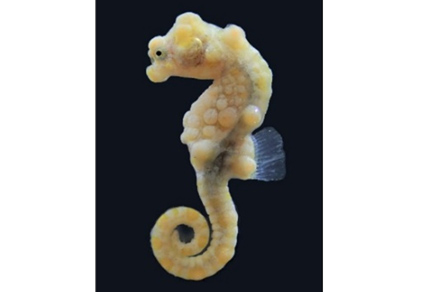Abstract
During a scientific expedition in the Taiwan Bank in the southern Taiwan Strait in 2021, five pygmy seahorses, measuring between 18.1 mm and 28.3 mm in standard length, were inadvertently collected along with Muricella sea fans. Morphometric measurements of these pygmy seahorse specimens coincided with the previous data on H. bargibanti, but they had a proportionally greater head depth and snout length. Genetically, DNA marker analysis of partial mitochondrial COI sequences confirmed that our specimens belonged to the same lineage as H. bargibanti, with a p-distance of 0.54% among populations. This discovery enhances our knowledge of the limited biodiversity in the Taiwan Bank, which includes a complex geomorphology of both reef banks and sandy substrates, and highlights the importance of strict laws prohibiting fishing with inadequate gear, invasive or illegal fishing, and sand dredging to protect unexplored coral reef biodiversity in the area.
References
- Baine, M.S.P, Barrows, A.P.W, Ganiga, G. & Martin-Smith, K.M. (2008) Residence and movement of pygmy seahorses, Hippocampus bargibanti, on sea fans (Muricella spp.). Coral Reefs, 27, 421. https://doi.org/10.1007/s00338-007-0352-5
- Gomon, M.F. (1997) A remarkable new pygmy seahorse (Syngnathidae: Hippocampus) from south-eastern Australia, with re-description of H. bargibanti Whitley from New Caledonia. Memoirs of Museum Victoria. 56, 245−253. https://doi.org/10.24199/j.mmv.1997.56.10
- Gomon, M.F. & Kuiter, R.H. (2009) Two new pygmy seahorses (Teleostei: Syngnathidae: Hippocampus) from the Indo-West Pacific. Cybium, 15, 37–44.
- Heard, J., Chen, J.P. & Wen, C.K.C. (2019) Citizen science yields first records of Hippocampus japapigu and Hippocampus denise (Syngnathidae) from Taiwan: A hotspot for pygmy seahorse diversity. ZooKeys, 883, 83–90. https://doi.org/10.3897/zookeys.883.39662
- Jeng, M.S. (2019) Ecological catastrophe of massive sand extraction in the Taiwan Bank. The Nature, 42, 36–45. [in Chinese]
- Koning, S. & Hoeksema, B.W. (2021) Diversity of seahorse species (Hippocampus spp.) in the international aquarium trade. Diversity, 13 (5), 187. https://doi.org/10.3390/d13050187
- Kuiter, R.H. (2003) A new pygmy seahorse (Pisces: Syngnathidae: Hippocampus) from Lord Howe Island. Records of the Australian Museum, 55, 113–116. https://doi.org/10.3853/j.0067-1975.55.2003.1382
- Kumar, S., Stecher, G., Li, M., Knyaz, C. & Tamura, K. (2018) MEGA X: Molecular Evolutionary Genetics Analysis across computing platforms. Molecular Biology and Evolution, 35, 1547–1549. https://doi.org/10.1093/molbev/msy096
- Lan, K.W., Kawamura, H., Lee, M.A., Chang, Y., Chan, J.W. & Liao, C.H. (2009) Summertime sea surface temperature fronts associated with upwelling around the Taiwan Bank. Continental Shelf Research, 29, 903–910. https://doi.org/10.1016/j.csr.2009.01.015
- Lee, C.H. (2021) Coping strategy to transgressive activity of sand pump dredgers of Mainland China. Navy Professional Journal, 55 (5), 72–86. [in Chinese]
- Lourie, S.A. & Kuiter, R.H. (2008) Three new pygmy seahorse species from Indonesia (Teleostei: Syngnathidae: Hippocampus). Zootaxa, 1963, 54–68. https://doi.org/10.11646/zootaxa.1963.1.4
- Lourie, S.A., Pollom, R.A. & Foster, S.J. (2016) A global revision of the seahorses Hippocampus Rafinesque 1810 (Actinopterygii: Syngnathiformes): Taxonomy and biogeography with recommendations for further research. Zootaxa, 4146, 1–66. https://doi.org/10.11646/zootaxa.4146.1.1
- Lourie, S.A., Pritchard, J.C., Casey, S.P., Ky, T.S. & Vincent, A.C.J. (1999) The taxonomy of Vietnam’s exploited seahorses. Biological Journal of the Linnean Society, 66 (2), 231–256. https://doi.org/10.1111/j.1095-8312.1999.tb01886.x
- Lourie, S.A. & Randall, J.E. (2003) A new pygmy seahorse, Hippocampus denise (Teleostei Syngnathidae) from the Indo-Pacific. Zoological Studies, 42, 284–291.
- Lu, T.H., Lin, C.C., Chen, F.S. & Chung, C.S. (1986) Investigations of round herring and squids fishing-grounds from Pescadores to Formosa Bank in 1984. Bulletin of Taiwan Fisheries Research Institute, 40, 35–51. [in Chinese]
- Reijnen, B.T., van der Meij, S.E.T. & van Ofwegen, L.P. (2011) Fish, fans and hydroids: host species of pygmy seahorses. ZooKeys, 103, 1–26. https://doi.org/10.3897/zookeys.103.953
- Shepherd, B., Wandell, M. & Ross, R. (2017) Mating, birth, larval development and settlement of Bargibant's pygmy seahorse, Hippocampus bargibanti (Syngnathidae), in aquaria. Aquaculture, Aquarium, Conservation & Legislation, 10 (5), 1049–1063.
- Short, G., Claassens, L., Smith, R., De Brauwer, M., Hamilton, H., Stat, M. & Harasti, D. (2020) Hippocampus nalu, a new species of pygmy seahorse from South Africa, and the first record of a pygmy seahorse from the Indian Ocean (Teleostei, Syngnathidae). ZooKeys, 934, 141–156. https://doi.org/10.3897/zookeys.934.50924
- Short, G., Smith, R., Motomura, H., Harasti, D., Hamilton, H. (2018) Hippocampus japapigu, a new species of pygmy seahorse from Japan, with a redescription of H. pontohi (Teleostei, Syngnathidae). ZooKeys, 779, 27–49. https://doi.org/10.3897/zookeys.779.24799
- Smith, R.E., Grutter, A.S. & Tibbetts, I.R. (2012) Extreme habitat specialisation and population structure of two gorgonian-associated pygmy seahorses. Marine Ecology Progress Series, 444, 195–206. https://doi.org/10.3354/meps09471
- Teske, P.R., Cherry, M.I. & Matthee, C.A. (2004) The evolutionary history of seahorses (Syngnathidae: Hippocampus): molecular data suggest a West Pacific origin and two invasions of the Atlantic Ocean. Molecular Phylogenetics and Evolution, 30, 273–286. https://doi.org/10.1016/S1055-7903(03)00214-8
- Tsai, P.C., Yeh, H.M., Chan, B.K.K. & Chan, T.Y. (2009) Comparison between the catch composition of the French and ORE type beam trawls on deep-sea decapod crustaceans: implications for quantitative sampling of the deep-sea decapod biodiversity. Crustaceana, 82 (5), 565–591. https://doi.org/10.1163/156854008X390326
- Weng, J.S., Cheng, L.C., Lo, Y.S., Shiao, J.C., He, J.S., Lee, M.A. & Liu, K.M. (2021) Demographics of Scomberomorus commerson in the central Taiwan Strait. Journal of Marine Science and Engineering, 9, 1346. https://doi.org/10.3390/jmse9121346
- Whitley, G.P. (1970) Bargibant’s sea-horse from New Caledonia. Proceedings of the Linnean Society of New South Wales, 94 (3), 294.


